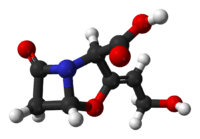Clavulanic acid
 | |
|---|---|
 | |
| Systematic (IUPAC) name | |
| (2R,5R,Z)-3-(2-hydroxyethylidene)-7-oxo-4-oxa-1-aza-bicyclo[3.2.0]heptane-2-carboxylic acid | |
| Clinical data | |
| AHFS/Drugs.com | International Drug Names |
| Pregnancy cat. | B (USA) B1 (Aust) |
| Legal status | Schedule 4 (Au) rx only |
| Routes | oral, IV |
| Pharmacokinetic data | |
| Bioavailability | "well absorbed" |
| Metabolism | hepatic (extensive) |
| Half-life | 1 hour |
| Excretion | renal (30–40%) |
| Identifiers | |
| CAS number | 58001-44-8 |
| ATC code | J01CR (combinations with penicillins) |
| PubChem | CID 5280980 |
| DrugBank | DB00766 |
| ChemSpider | 4444466 |
| UNII | 23521W1S24 |
| KEGG | D07711 |
| ChEBI | CHEBI:48947 |
| ChEMBL | CHEMBL777 |
| Chemical data | |
| Formula | C8H9NO5 |
| Mol. mass | 199.16 |
| SMILES
| |
| |
| | |
Clavulanic acid (rINN) /klævjuːˌlænɨk ˈæsɨd/ is a mechanism-based β-lactamase inhibitor (marketed by GlaxoSmithKline) combined with penicillin group antibiotics to overcome certain types of antibiotic resistance.
It is used to overcome resistance in bacteria that secrete β-lactamase, which otherwise inactivates most penicillins.
In its most common form, the potassium salt potassium clavulanate is combined with:
- amoxicillin (co-amoxiclav, trade names Augmentin,Tyclav (Beximco) Synulox [veterinary], and others) or
- ticarcillin (co-ticarclav, trade name Timentin).
Clavulanic acid is an example of a clavam.
Sources
The name is derived from the Streptomyces clavuligerus, which produces clavulanic acid.[1][2]
Clavulanic acid is biosynthetically generated from the amino acid arginine and the sugar glyceraldehyde 3-phosphate.
History
Clavulanic acid was discovered around 1974/75 by British scientists working at the drug company Beecham. After several attempts, Beecham finally filed for US patent protection for the drug in 1981, and U.S. Patents 4,525,352, 4,529,720, and 4,560,552 were granted in 1985.
Mechanism of action
Clavulanic acid has negligible intrinsic antimicrobial activity, despite sharing the β-lactam ring that is characteristic of β-lactam antibiotics. However, the similarity in chemical structure allows the molecule to interact with the enzyme β-lactamase secreted by certain bacteria to confer resistance to β-lactam antibiotics.
Clavulanic acid is a suicide inhibitor, covalently bonding to a serine residue in the active site of the β-lactamase. This restructures the clavulanic acid molecule, creating a much more reactive species that is attacked by another amino acid in the active site, permanently inactivating it, and thus inactivating the enzyme.
This inhibition restores the antimicrobial activity of β-lactam antibiotics against lactamase-secreting resistant bacteria. Despite this, some bacterial strains that are resistant even to such combinations have emerged.
Adverse effects
The use of clavulanic acid with penicillins has been associated with an increased incidence of cholestatic jaundice and acute hepatitis during therapy or shortly after. The associated jaundice is usually self-limiting and very rarely fatal.[3][4]
The UK Committee on Safety of Medicines (CSM) recommends that treatments such as amoxicillin/clavulanic acid preparations be reserved for bacterial infections likely to be caused by amoxicillin-resistant β-lactamase-producing strains, and that treatment should not normally exceed 14 days.
References
- ↑ Arulanantham H, Kershaw NJ, Hewitson KS, Hughes CE, Thirkettle JE, Schofield CJ (January 2006). "ORF17 from the clavulanic acid biosynthesis gene cluster catalyzes the ATP-dependent formation of N-glycyl-clavaminic acid". J. Biol. Chem. 281 (1): 279–87. doi:10.1074/jbc.M507711200. PMID 16251194.
- ↑ Tahlan K, Park HU, Wong A, Beatty PH, Jensen SE (March 2004). "Two sets of paralogous genes encode the enzymes involved in the early stages of clavulanic acid and clavam metabolite biosynthesis in Streptomyces clavuligerus". Antimicrob. Agents Chemother. 48 (3): 930–9. doi:10.1128/AAC.48.3.930-939.2004. PMC 353097. PMID 14982786.
- ↑ Joint Formulary Committee. British National Formulary, 47th edition. London: British Medical Association and Royal Pharmaceutical Society of Great Britain; 2004.
- ↑ "Drug Record - Amoxicillin-Clavulanate". LiverTox - Clinical and Research Information on Drug-Induced Liver Injury. Retrieved April 24, 2013.
- ↑ Tortajada Girbés M, Ferrer Franco A, Gracia Antequera M, Clement Paredes A, García Muñoz E, Tallón Guerola M (2008). "Hypersensitivity to clavulanic acid in children". Allergol Immunopathol (Madr) 36 (5): 308–10. doi:10.1016/S0301-0546(08)75228-5. PMID 19080805.
| ||||||||||||||||||||||||||||||||||||||||||||||||||||||||||||||||||||||